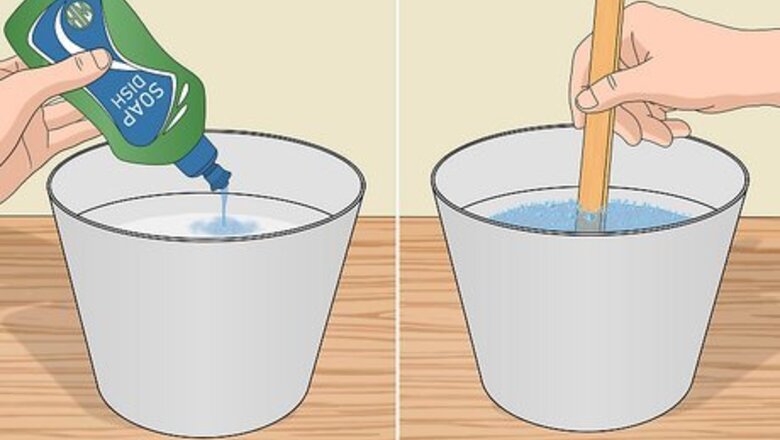
views
Washing Dirty Rubber
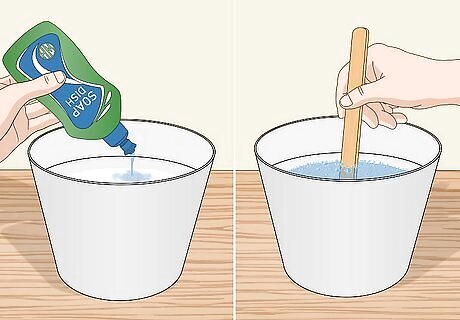
Make a cleaning solution with dish soap and water. Fill a bucket with roughly 1 gallon (3.8 L) of warm water. Add 1 tbsp (15 ml) of dish soap to the water. Stir the solution with your clean hands or a utensil, like a wooden spoon, until the soap is distributed throughout and bubbles form.
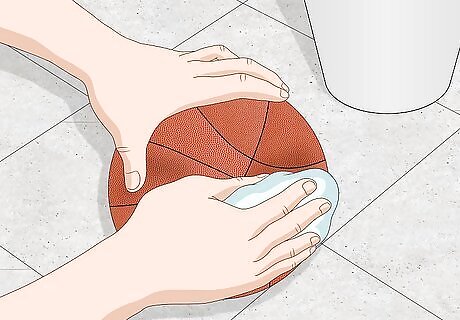
Use a dampened cloth to wipe the surface. Dip a clean cloth or rag into the solution. Remove the rag and wring out excess solution into the bucket. Scrub dirty rubber firmly with your cloth until it is clean. Your cleaning cloth will absorb dirtiness while cleaning. Remove this by dunking the cloth in the solution and wringing it out over the bucket. Avoid using abrasive cleaners and cleaning tools. These can deform or cloud the surface of your rubber.
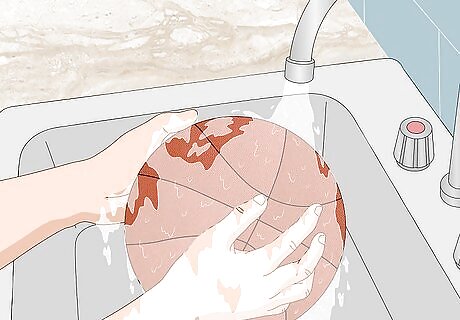
Rinse remaining solution from the rubber. Once the dirtiness has been removed, turn on your sink and run the rubber under the faucet to rinse away all soap from the rubber. The leftover solution can be used for other cleaning projects or dumped down the drain. Jeff Campbell Jeff Campbell, Cleaning Expert When it comes to cleaning rubber materials, start by removing any loose dirt or debris with a soft brush. Then create a mild soap solution — dish soap diluted in warm water works well — and use a sponge or rag to gently scrub the rubber. Be sure to thoroughly rinse off any soap residue. For tough stains, a paste of baking soda and water can help lift discoloration.
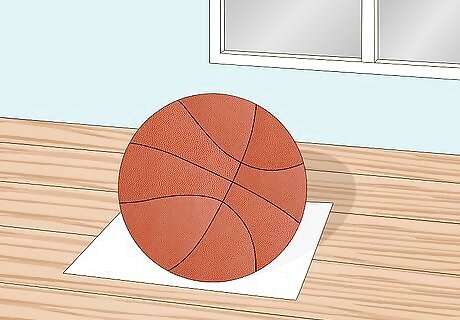
Allow the rubber to air dry. Choose a spot out of the sun when air drying rubber. Sunlight will break down rubber over time. Avoid using direct heat to dry rubber, as this can also damage it. Speed up dry times by blowing air on drying rubber with a hairdryer set to “Cool.” In some cases, it may seem as though the rubber is cleaned while wet, but when it dries, stickiness may remain. Clean remaining stickiness a second time with soapy water as described, or use rubbing alcohol in the fashion described in the following step.
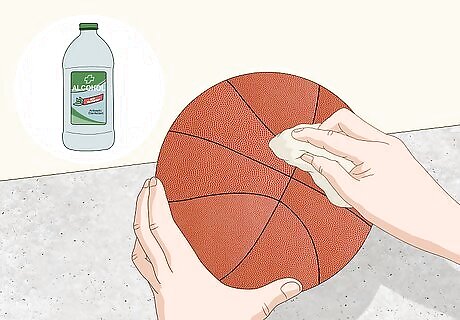
Use rubbing alcohol for stubborn stickiness. Although alcohol is an effective cleaner for most kinds of stickiness, you should only use this cleaning agent on rubber occasionally. Dampen a clean rag with alcohol and wipe at sticky areas until they are removed. Rinse the rubber with water afterwards. Exposing rubber too often or too long to alcohol may cause it to break down more quickly than normal.
Removing Stains from Rubber
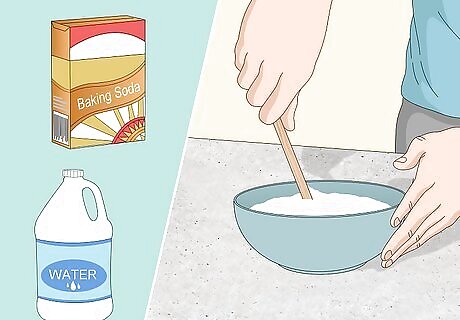
Mix together a paste made from baking soda and warm water. Combine 1 part warm water with 3 parts baking soda in a small mixing bowl. Fold the baking soda into the water with a spoon until it reaches a paste-like consistency. If the mixture is too runny, add more baking soda. If the mixture gets too thick, add a splash of water.
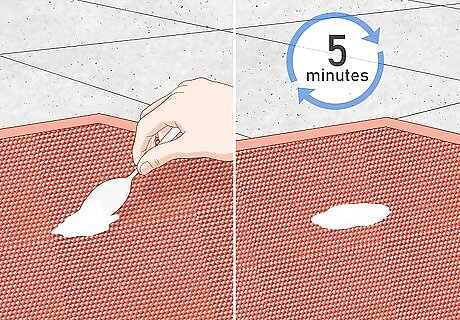
Cover the stain with the baking soda paste and let it sit for 5 minutes. Spoon the baking soda paste onto the stain and spread it out so it forms a thin layer. Leave the baking soda alone for at least 5 minutes so it has a chance to absorb the stain. If the stain is persistent against other cleaning methods, leave the baking powder on for at least 15 minutes.
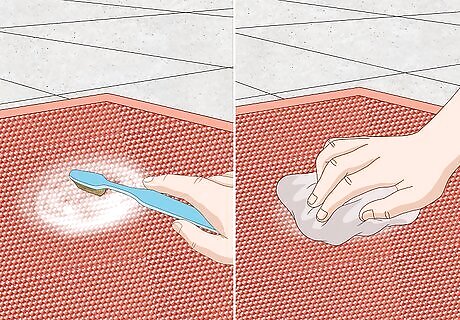
Scrub the paste off with a toothbrush and cleaning cloth. Work in a circular motion across the surface of the stain to work the paste into it more. When you’ve finished scrubbing the stain with your toothbrush, wipe away any excess paste with a clean rag. If it is a large stain, then use a stiff-bristled cleaning brush.
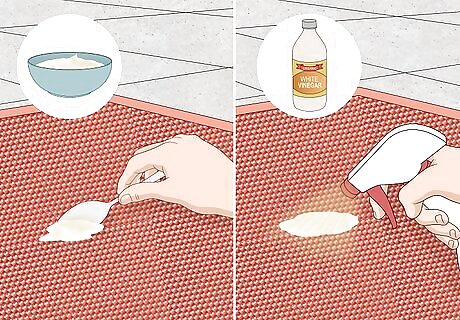
Reapply the paste with vinegar if the stain persists. If there’s still a stain after the first time you scrubbed it, put on another layer of the baking soda. This time, use a spray bottle filled with white vinegar to help lift the stain even more. Allow the paste to sit for another 5 minutes before scrubbing it off.
Cleaning Rubber Mats
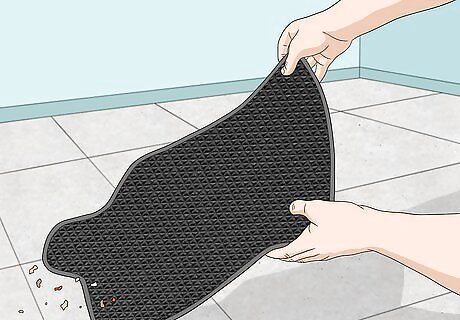
Remove loose dirtiness from the mats. Remove the rubber mats from your home or vehicle. Take them outside and shake them to remove loose debris. Clap mats together or hit them against a wall or railing to more thoroughly remove dirt, dust, stones, and more.
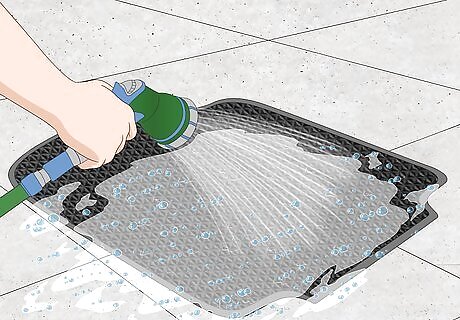
Rinse the mats with the spray attachment of a garden hose. Alternatively, you can use a pressure washer to blast away dirtiness from rubber mats. Turn on the water supply and spray all parts of the mats with water. Rubber mats are usually designed to be durable. Mats that are flimsy, delicate, or that have a finished surface may be damaged by power washers. Power washers may spray water hard enough to blow away the mat. If this happens to you, use a clean, heavy item to weigh the mat down. Remember to clean under the item as well.

Scrub the mats with a brush and soapy water. Add a moderate amount of dish soap to a bucket of warm water. Mix the water until bubbles form. Wet the bristles of a stiff bristle brush with the cleaning solution. Scrub the mats firmly to remove stubborn buildup, spots, and so on. While cleaning, pay close attention to nooks, crannies, and corners. Dirt and debris often collect in these places. Rubber that has a finished surface or is fragile may be damaged by brushes that are too stiff. Clean an out of sight area of the mat with the brush first to determine whether it’ll harm the rubber.
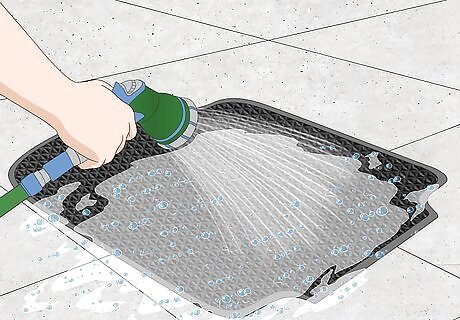
Rinse the mats after cleaning. Use your hose or power washer to rinse the mats entirely. Look over your mats one more time. Target remaining dirtiness with your scrub brush and cleaning solution. Then rinse away the cleaning solution one more time.
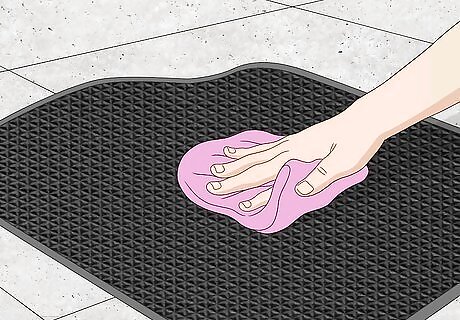
Dry mats with a microfiber towel. Take a dry towel and wipe down your mats to remove water. When the mats are dry, return them to your car. If you don’t have a suitable towel available, air dry your mats. Refrain from drying your mats in the sun, as this can cause the rubber to weaken.
Removing Dirtiness from Rubber Tires
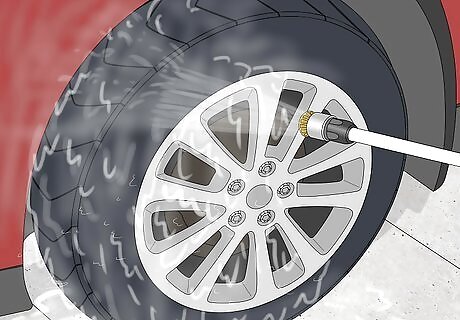
Spray tires with water to remove buildup. The dirt and grime that builds up on your tires can be especially difficult to remove. Spray all surfaces of the tire with a high pressure stream of water with a power washer or hose. A power washer is preferred for tire cleaning to more easily remove buildup, though a hose with a spray attachment should work in a pinch. If you are also planning on washing your car, be sure to do so after cleaning your tires. Cleaning tires after washing your car may spread dirtiness to already cleaned parts of the car.
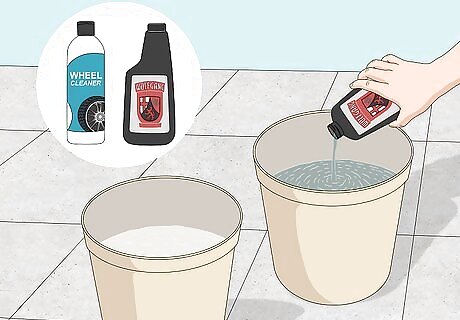
Fill one bucket with cleaning solution and another with clean water. Add a suitable tire cleaner, like Simple Green or Wolfgang Tire and Wheel Cleaner, to a bucket. Each cleaner will be different; always follow the label instructions. Fill your second bucket with cool water. If you are unsure what cleaner is best for your tires, check your car’s manual for more detailed care instructions. If you don’t have a special tire cleaner, use a moderate amount of dish soap in a bucket of cool water. Mix the solution to distribute the soap before applying it to the tire. Severely dirty tires may need an extra strong cleaning agent, like Bleche-Wite Tire Cleaner or Pinnacle Advanced Wheel Cleaner Concentrate.
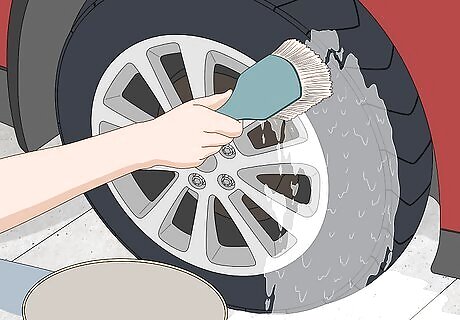
Scrub away remaining dirtiness. Dip a stiff bristle brush into the cleaning solution. Clean tires with soap one at a time. Scrub a tire firmly to remove buildup and dirtiness. Rinse the brush in the bucket filled with water when it becomes saturated with dirtiness. Prevent cleaning agents from drying on the rubber of your tire. Doing so can cause tires to deteriorate more quickly.
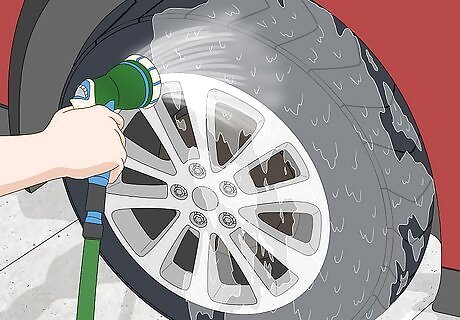
Rinse soap from the tire completely. Use your power washer or hose to remove any remaining soap or loosened dirtiness from the tire. Be thorough when rinsing your tire so that the soap is completely rinsed away.

Dry the tire and wheel. A microfiber drying cloth will work best, but you can also use an old terry cloth towel. Do not use tire-drying cloths on other parts of your car. Dirt, dust, and small stones in the fabric of the drying cloth may scratch the paint job of your car. Forgetting to dry the tire after cleaning them could result in water spots or missed dirtiness. Carefully dry the entire tire and wheel.
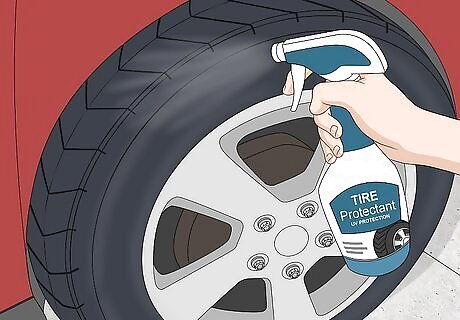
Apply protectant to the tire. These can be bought at your local auto store or in the automotive section of most general retailers. Choose a product with UV protection and be sure it doesn’t have any solvent based silicone. Follow the label instructions on your protectant to achieve the best results. Generally, protectant is applied directly to tires with an applicator, cloth, or sponge. Protectant may contain harsh chemicals and require gloves for safe use. Applying protectant to your tires will maintain their condition for longer and protect them from getting dirty again. In most cases, protectants that are milky in color are water based and most suitable for tires. Protectants that are slick and clear likely contain harmful solvent-based silicone.

Repeat this process to clean the remaining dirty tires. Now that the first tire has been sprayed, scrubbed, rinsed, and dried, you can move on to the next tire. Clean each tire and wheel in the fashion described until all tires are clean. If you plan on washing your car immediately after cleaning your tires, keep the tires wet after cleaning until the entire care is clean. Dry tires and the body of your care with separate cloths.
Cleansing Rubber Bath Toys
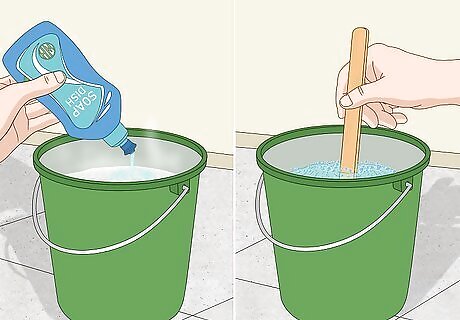
Add soap and water to a bucket to make your cleaning solution. Dish soap is mild and won’t damage your bath toys. Combine a moderate amount of soap with hot water in a bucket. Stir the hot solution with a utensil, like a wooden spoon.
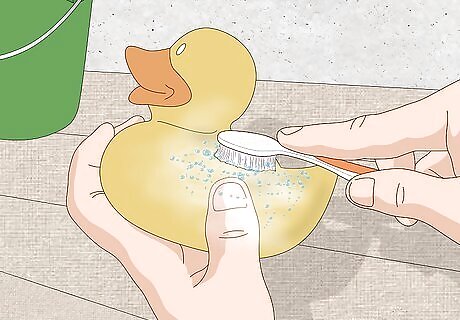
Scrub toys with a soft bristle brush. Stick a soft bristle brush, like a toothbrush, into the cleaning solution. Scrub dirty areas of toys until they are clean. Rinse the toys in warm water when you finish cleaning. Clean toys weekly.
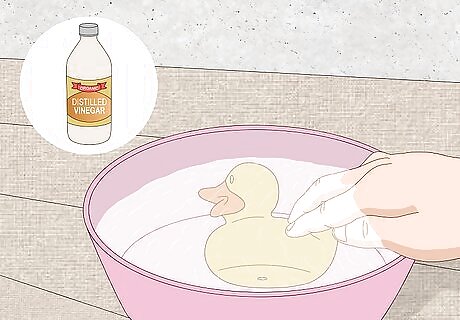
Soak toys in distilled vinegar to kill mold. Toys that are severely afflicted with mold should be thrown away. Mold spores can be dangerous to your health and your children’s as well. Light mold can be killed by soaking the toys for at least 10 minutes in a solution made up of half hot water and half vinegar. Vinegar is also a useful cleaner for difficult to remove scum buildup. Simply soak the toys in vinegar as described to remove scum. Soaking toys in vinegar should loosen mold, scum, and stubborn dirtiness. Any that remains following the soak should be scrubbed with a soft bristle brush, like a toothbrush.
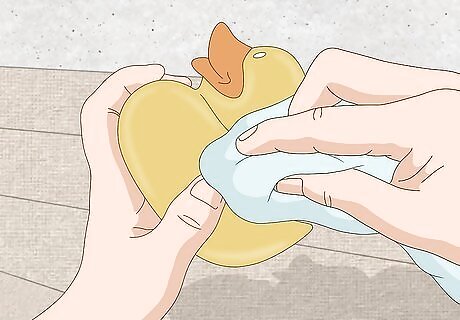
Dry the rubber toys. Wipe excess moisture from your rubber toys with a clean cloth. Because moisture often gets trapped inside the toy, allow the toys to air dry after you use a towel. Avoid drying toys in sunlight, as this can cause the rubber to weaken.

Close toy openings with hot glue to prevent mold. Water trapped inside bath toys can encourage the growth of mold. Clean and dry toys completely, then use a glue gun to seal any holes in the toy.




















Comments
0 comment